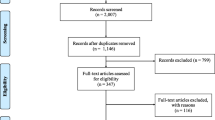Abstract
This paper attempts to answer the question: What accounts for the universal rise in interest in complementary and alternative medicine (CAM), the growth of practitioners and potential patients seeking them out? It is recognised that there is great diversity both within CAM (in terms of philosophy, methodology, research) as well as between CAM and orthodox medicine. The limited empirical research concerning why people choose a CAM practitioner is reviewed. Six major reasons are given to answer the above question recognising their relationships to one another and that other reasons do exist. There is no typical patient, although the results do suggest that certain individuals based on their demography, medical history and belief system are most likely to choose CAM.
Similar content being viewed by others
References
Aakster C. 1986. Concepts in alternative medicine. Soc Sci Med, 22: 265–73.
Abbot N, White A, Ernst E. 1996. Complementary medicine. Nature, 381:361.
Bergin A, Garfield S. 1994. Handbook of psychotherapy and behaviour change. Chichester: Wiley.
Cassileth B. 1988. Unorthodox cancer medicine. Cancer Invest, 4: 591–8.
Easthope G, Tranter B, Gill G. 2000. General practitioners’ attitudes toward complementary therapies. Soc Sci Med, 51:1555–61.
Eisenberg D, Davis R, Ettner S et al. 1998. Trends in alternative medicine use in the national survey. J Am Med Assoc, 11:1569–75.
Eisenberg D, Kessler R, Foster C et al. 1993. Unconventional medicine in the United States: prevalence, costs and patterns of use. N Engl J Med, 328:246–52.
Ernst E. 1997. Homeopathy: past, present and future. Br J Clin Pharmacol, 44:435–7.
Ernst E. 2000. The British House of Lords enquiry into complementary and alternative medicine. Focus Altern Complement Therap, 5:3–5.
Ernst E, Furnham A. 2000. BMWs and complementary/alternative medicine. Focus Altern Complement Therap, 5:253–4.
Ernst E, Kaptchuk T. 1996. Complementary medicine — the case for dialogue. J R Coll Physicians Lond, 30:410–12.
Ernst E, Pittler M. 1998. The effectiveness of acupuncture in treating acute dental pain: a systematic review. Br Dent J, 184:443–7.
Ernst E, Willoughby M, Weihmayr T. 1995. Nine possible reasons for choosing complementary medicine. Perfusion, 8:356–9.
Fisher P, Ward A. 1994. Complementary medicine in Europe. Br Med J, 309:107–11.
Furnham A. 1999. Ignorance about homeopathy. J Altern Complement Med, 5:475–8.
Furnham A. 2000. How the public classify complementary medicine: a factor analytic study. Complement Therap Med, 8:82–7.
Furnham A. 2002. Complementary and alternative medicine. Psychologist, 15:228–31.
Furnham A, Kirkaldy B. 1995. The health beliefs and behaviours of orthodox and complementary medicine clients. Br J Clin Psychol, 25:49–61.
Furnham A, Vincent C. 2000. Reasons for using CAM. In Kelner M, Wellman B, eds. Complementary and alternative medicine. Amsterdam: Harwood. p 61–78.
Furnham A, Vincent C. 2001. Cultivating health through complementary medicine. In MacLacllan M, ed. Cultivating health. Chichester: Wiley. p 113–31.
Gray R. 1998. Four perspectives on unconventional therapy. Health, 2: 55–74.
Hertschel G, Kohren R, Hauser G et al. 1996. Complementary medicine today: patient decision for physician or magician. Eur J Physical Med Rehabil, 6:144–50.
Kelner M, Wellman B. 1997. Who seeks alternative care? A profile of the users of five modes of treatment. J Altern Complement Med, 3: 127–40.
Thomas K, Carr J, Westlake L et al. 1991. Use of non-orthodox and conventional health care in Great Britain. Br Med J, 302:207–10.
Turner R. 1998. A proposal for classifying complementary therapies. Complement Therap Med, 6:141–3.
Vincent C, Furnham A. 1996. Why do patients turn to complementary medicine? Br J Clin Psychol, 35:37–48.
Vincent C, Furnham A. 1997. Complementary medicine: a research perspective. Chichester: Wiley.
Vincent C, Furnham A. 1999. Complementary medicine: state of the evidence. J R Soc Med, 92:170–7.
White A, Ernst E. 2000. Economic analysis of complementary medicine: a systematic review. Complement Therap Med, 8:111–18.
Author information
Authors and Affiliations
Corresponding author
Rights and permissions
About this article
Cite this article
Furnham, A. The psychology of complementary and alternative medicine. Evid-Based-Integrative-Med 1, 57–64 (2004). https://doi.org/10.2165/01197065-200301010-00010
Published:
Issue Date:
DOI: https://doi.org/10.2165/01197065-200301010-00010




